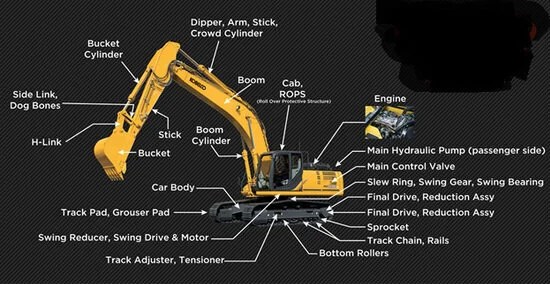Most technical people in the area of user interfaces know what it means to exit a program. And most engineers in the area of heavy industry work machines know what a swing gear does on an excavator. But that does not mean the USPTO will apply such understandings. As we have discussed in previous posts, the Broadest Reasonable Interpretation (in light of the specification) is applied, but usually in a way that errs on the side of breadth. Despite the mandate that the understanding of one skilled in the art be considered, often the outcome of the USPTO’s interpretation is beyond what was intended by the applicant.
The USPTO explains the issue as follows:
Under a broadest reasonable interpretation (BRI), words of the claim must be given their plain meaning, unless such meaning is inconsistent with the specification. The plain meaning of a term means the ordinary and customary meaning given to the term by those of ordinary skill in the art at the time of the invention.
Two recent PTAB decisions illustrate how important BRI can be – it is often the issue that decides whether the claims are patentable or not.
In Appeal 2020-004318 (Application 15/348,503), Microsoft’s invention related to dynamically providing application analytic information and binary rewriting of an application file. As part of that, the claimed method of claim 2 included executing, via the processor, the new application file to detect the page navigation information, the page navigation information comprising pages viewed by a user upon exiting the new application file. At issue in the appeal was the meaning of “exit.” The examiner had applied a prior art combination, but the combination was apparently missing disclosure of performing the execution of the new application where the detected page navigation information was pages view by a user upon exiting the new application file. The examiner concluded that exiting was broad enough to simply cover when a user stops using or interacting with the application, even if the application is left running.
While most everyone who has used a computer in the last 30 years knows what it means to exit an application, the PTAB found otherwise. They first looked to the specification and were critical of the drafting by noting that:
… the term “exit” appears only once in Appellant’s Specification. Ans. 26–27 (citing Spec. ¶ 80). Paragraph 80 uses language similar to that used in claim 2, namely “information about which pages are being used when users exit the application.” Spec. ¶ 80. Appellant fails to identity any express definition of the claim term “exiting” in the Specification that requires the claimed “exiting” to require “terminating all windows or processes of an application.”
Appellant has not persuaded us that the ordinary meaning of the claim term “exiting the new application file,” applied by the Examiner, which merely requires the user to stop using or interacting with the application, is inconsistent with the Specification. Nor has Appellant persuaded us that the Examiner’s interpretation of “exiting the new application file” is overly broad or unreasonable.
Parker-Hannifin Corporation’s application (15/925,821) relates to an excavator having various components, including an “excavator swing mechanism” and various pump/motors, including one “mechanically connected to the excavator swing mechanism” among other limitations. Claim 1 is below:
An excavator comprising:
a prime mover;
an excavator swing mechanism;
a first hydraulic pump/motor mechanically connected to the prime mover;
a second hydraulic pump/motor mechanically connected to the excavator swing mechanism;
a hydraulic fluid reservoir;
a hydraulic accumulator;
a hydraulic circuit connecting the hydraulic fluid reservoir, the hydraulic accumulator, the first hydraulic pump/motor, and the second hydraulic pump/motor;
wherein, in a first mode, the second hydraulic pump/motor acts as a pump to retard movement of the
excavator swing mechanism and pressurized hydraulic fluid from the second hydraulic pump/motor is pumped into the hydraulic accumulator; and
wherein, in a second mode, the second hydraulic pump/motor acts as a motor to provide power to the excavator swing mechanism using pressurized fluid from the hydraulic accumulator.
As issue on appeal was whether the examiner’s interpretation of the excavator swing mechanism was reasonable under BRI. The examiner had applied prior art where a winch was alleged to be the “excavator swing mechanism.” At first glance, this seems ridiculous given a technical understanding of excavators and how slewing mechanisms work. See the images below.

Parker argued as follows:
The ordinary and customary meaning of excavator swing mechanism, i.e. a structure that is configured to rotate the upper structure of the excavator relative to the undercarriage of the excavator, is also consistent with the specification, which sets forth that the drive system 10 includes a hydraulic swing drive system and forms part of an excavator 8 which includes an upper structure, undercarriage, swing, boom, arm and bucket of the excavator 8. (Specification at page 7, lines 6–9.) The specification further describes propulsion of the swing mechanism 70 to one side in normal operation. (Specification at page 10, lines 4–6.) As set forth in the background section of the present application, the present application aims to solve a technical problem that is particular to the swing drive of an excavator which is the source of a large amount of energy loss in the excavator.
… The person having ordinary skill in the art of excavators would understand that the term ‘excavator swing mechanism’ is not intended to pertain to a winch which has an entirely different structure and function. … The Examiner’s position suggests that a winch and an excavator swing mechanism are interchangeable components that are capable of performing the same function for the excavator. This is not plausible given the distinct structural and functional features of the components.
Nevertheless, the PTAB found the interpretation reasonable. The PTAB looked to the specification to see if there was an explicit definition. Finding none, the PTAB interpreted the claim term as “a mechanism that is swung by a hydraulic motor” without further defining their interpretation of “swung.” As you can already see, this spells trouble for the applicant. From there, the PTAB simply concludes:
Given our interpretation of “excavator swing mechanism,” we determine Schneider’s winch is encompassed by the claim language because Schneider’s winch is a mechanism that is swung by a hydraulic motor.
What is unclear is how a winch is “swung.” From a brief review, Schneider’s system shows a prime mover driving a winch through a transmission with various hydraulic motors and pumps.
It is very easy to overlook BRI issues when drafting because the drafter’s mind can be acutely focused on describing the invention and addressing a whole host of issues from supporting claim elements to providing advantages and additional details that may be needed for amendments during prosecution. And sometimes, the more familiar the drafter is with the technology of the invention, the easier it is to miss the opportunity for an examiner to make a devastatingly over-broad interpretation. As illustrated in the cases above, the validity of the rejection turned on interpretations of words that seem painfully clear upon initial drafting.
What are some ways to guard against these issues? One aspect we have often used is a fresh set of eyes review for every application by someone in the firm not involved or responsible for the normal drafting and review. While this is often a third set of eye, the feedback can be invaluable.

Leave a comment